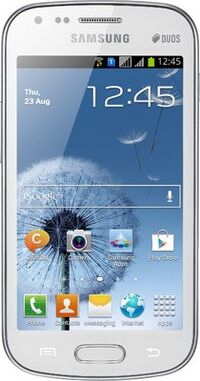Samsung Galaxy S Duos (samsung-s7562): Difference between revisions
Appearance
m →not booting: fix table |
m Update codename |
||
| Line 2: | Line 2: | ||
| manufacturer = Samsung | | manufacturer = Samsung | ||
| name = Galaxy S Duos | | name = Galaxy S Duos | ||
| codename = s7562 | | codename = samsung-s7562 | ||
| image = File:Samsung Galaxy S Duos.jpg | | image = File:Samsung Galaxy S Duos.jpg | ||
| imagecaption = Samsung Galaxy S Duos | | imagecaption = Samsung Galaxy S Duos | ||
Revision as of 15:35, 1 April 2020
| WARNING: This device is not recommended for future use with postmarketOS due to its armhf architecture. Alpine Linux (the distribution that postmarketOS extends) pmaports#599 has been considering dropping it. The processor of the device may support the armv7 architecture. If so, you can modify the device package and change the architecture accordingly. |
This device is marked as not booting.
 Samsung Galaxy S Duos | |
| Manufacturer | Samsung |
|---|---|
| Name | Galaxy S Duos |
| Codename | samsung-s7562 |
| Released | 2012 |
| Hardware | |
| Chipset | Qualcomm MSM7227A Snapdragon S1 |
| CPU | 1.0 GHz Cortex-A5 |
| GPU | Adreno 200 |
| Display | 480x800 IPS |
| Storage | 4 GB |
| Memory | 768 MB |
| Architecture | armhf |
| Software | |
| Original software | Android 4.0.1 on Linux 3.0.1 |
| postmarketOS | |
| Category | testing |
| Pre-built images | no |
Contributors
- cmdr2 on IRC
What works
- Compilation of kernel, system and initramfs
- pmOS starts up if a pre-compiled kernel (from the original boot.img) is used, along with the newly built initramfs and system image. Telnet, decrypt filesystem, and ssh (partially) works
What does not work
- pmOS does not boot with the newly built kernel. it only works if a pre-built factory kernel is used
- ssh fails with a 'cannot create channel 0' error, which can be bypassed with
ssh user@<ip> '/bin/sh'. With this, no prompt is shown (i.e. no "$" or "%"), but commands can be typed and executed and the results are displayed - No graphics are displayed on the screen, weston fails with
Failed to open frame buffer device ‘/dev/fb0’: No such file or directory